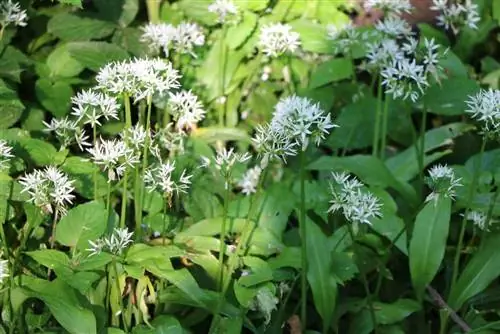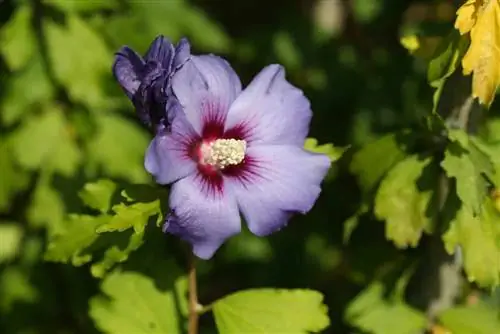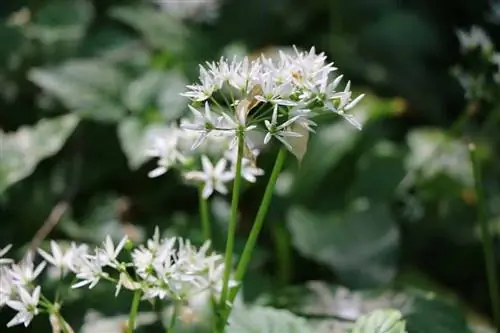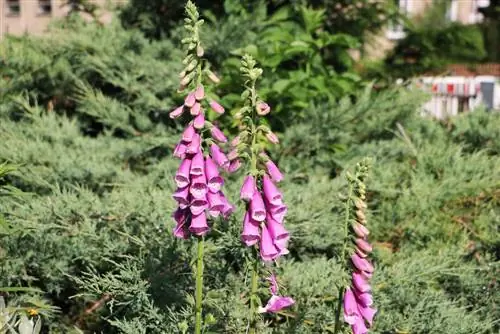- Author admin [email protected].
- Public 2023-12-17 03:39.
- Last modified 2025-01-24 12:45.
Wild herbs and wild vegetables are increasingly enriching the diet of many people and many of these delicacies can also be found in the forest or on the edge of the forest. Edible plants can be found in the forest almost all year round, even when there is a blanket of snow, trees with their buds offer small delicacies that not only animals appreciate, but can also be part of salads. In principle, however, when collecting, you should only take those plants that you can clearly recognize or identify and only take as much from nature as you need.
Delicious food on the forest path
The forest path is a treasure trove for edible plants because it is usually flooded with light than those areas with dense trees, which is why you can sometimes find plants that also grow in the meadow. However, the fact that they receive significantly less light can result in a slightly different appearance, for example that they have a lighter green or generally a smaller habitus. However, the plants are still edible and do not lose their taste.
Common plants along the forest path
- Broad plantain (Plantago major): The broad plantain is a typical path plant that feels particularly comfortable on shady and moist forest paths. It was only through the Roman conquerors that the broad plantain came north and came with the settlers to America, where the Indians called it the “white man's footprint” because it actually only grows on paths. The broadleaf plantain is easy to recognize by its broad egg-shaped leaves and its inflorescence, which resembles an ear of wheat. The young leaves of the broadleaf plantain can be used - older leaves should always be freed from the leaf veins and only used, cut into small pieces. The unbloomed inflorescence tastes like mushroom and can be used fresh or pickled in sweet and sour, for example.
- Dandelion (Taraxacum officinale): The dandelion is often mistakenly thought to be poisonous due to its white milky sap, but all parts of the plant can be eaten safely. The dandelion is often referred to as the “piss flower” because in folk medicine it is said to have a diuretic effect. The dandelion is recognizable by its strongly toothed elongated leaves, which are completely smooth and not hairy compared to other species that would be confused with the dandelion. In addition, the dandelion forms a rosette of bracts and spreads its leaves only slightly above the ground. The entire plant including the roots can be used. This can be drunk roasted and ground as a substitute coffee. The leaves are slightly bitter, which is due to the high content of bitter substances, but can easily be eaten with any wild vegetable dish. Closed buds are often fried or pickled sweet and sour. The flowers are also often collected in spring and processed into the well-known dandelion honey.
Tip:
As with collecting flowering wild herbs in the meadow, it is also possible to collect the flowers in the forest or on forest paths when there is a lot of sun, as that is when they are most aromatic.
Delicious Shrubs
There are numerous bushes that promise a rich harvest, especially in autumn, especially at the edge of the forest. The most common shrubs in the forest:
- Hazelnut bush (Corylus avellana): Everyone has probably eaten a hazelnut, which is unmistakably recognizable by the split nut fruits in autumn. There are countless myths surrounding hazelnut bushes, including the one that you forget time under the bush and can stay there forever. This definitely applies to high-yielding shrubs in autumn. The hazelnuts are harvested as soon as they have a firm, hard shell - if it can be damaged with just a thumbnail, it is still too early and the nut is not yet fully formed. If you want to harvest the nuts later, they are dried including the shell and stored with it, which means they retain their taste for the longest time.
- Black Elderberry (Sambucus nigra): There are also numerous legends and fairy tales surrounding the elderberry and it is not for nothing that the name resembles that of the fairy tale character of Mrs. Holle. This is particularly noticeable when the bush drops its spent flowers and it looks like it has snowed on the ground. The elderberry can be recognized by its porous gray-brown bark and the white flower umbels in spring. It can be confused with the red elder, which has yellowish flowers and red berries, or the attic, which blooms much later and has a more upright, low stature compared to the bushy habit of the elder. The flowers of the bush can be eaten in spring and the berries in autumn. However, black elderberry should always be processed warm as it contains the glycoside sambunigrin, which is incompatible with humans and is destroyed by heat.
Tip:
Unfortunately, wild animals are often faster, which is why you should regularly check the bushes for their degree of maturity so as not to be left behind.
Treat from the tree
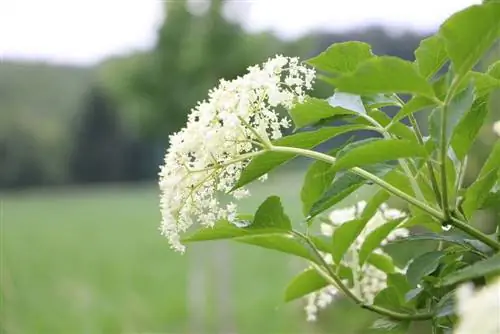
Of course, the forest also contains a number of edible plants in the form of trees. By harvesting buds, plants from the forest can be eaten almost all year round, but you should not take too many buds as this can damage the tree.
- Summer/winter linden tree (Tilia platyphyllos/ Tilia cordata): The winter linden tree is much more common in the forest and differs from the summer linden tree in the size of its leaves, but both are equally edible. The linden tree has particularly tasty buds and its green, unripe fruits can also be eaten in autumn. The white flower has an almost intoxicating scent and is used in teas.
- Spruce (Picea abies): The spruce is probably the most common forest tree in the forest and the so-called “Maywipferl” are mainly harvested in May. The spruce can be recognized from the related fir or other conifers with short needles such as the very poisonous yew by the simple saying: “The spruce stings, the fir (yew) does not.” The fresh light green shoots of the spruce are used, which are approx. sprout in May, up to a maximum length of 2 cm. They can be used fresh or made into syrups or similar.
Frequently asked questions
Do you have to be afraid of the fox tapeworm?
Many people are afraid of the fox tapeworm when it comes to forest plants, but this is unfounded, as the fox hangs around settlements and gardens much more often, as the food supply in compost heaps, for example, is significantly greater. There is only danger if signs of illness are not taken seriously and a doctor is not consulted, because an infection with the parasite can be easily treated.
Can you collect anywhere in the forest?
No. In principle, collecting is not permitted in nature reserves or if the forest owner forbids it through signs, for example. Otherwise, small quantities are permitted for household use unless there are other regional regulations.
What you should know about edible plants in brief
It's no secret that edible plants thrive in our gardens. Not only fruits and vegetables grow, other plants are also edible. There are also quite a few in the forest and meadows that can be eaten. Bedstraw, daisies, wood sorrel, wild garlic, dandelions, field mustard, sorrel, nettle, ribwort plantain and many others grow in meadows:
- All parts of the daisy can be eaten. The flowers make a good edible decoration in salads.
- Children especially like sorrel. Here too, all parts are edible.
- The taste is slightly sour, similar to lemon, but milder.
Wild garlic
Wild garlic grows both in meadows and even better in the forest. The leaves are really tasty. However, there is a risk of confusion here with the poisonous lilies of the valley. You can easily recognize wild garlic by its strong smell. The leaves are used in salads, pesto, soups, bread toppings and much more. Wild garlic is very versatile and extremely he althy.
- The leaves of dandelions are also edible. They are mainly used in salads and taste a bit bitter.
- Sorrel is also used. The leaves have a sour, lemon-like taste.
- The leaves of stinging nettles are used. But you should boil them so that the stinging hairs are destroyed. Nettle tea is popular and he althy.
- The leaves of ribwort plantain are used, mostly for mixed salads.
- Even groundweed, which is unwanted in the garden as a weed, doesn't taste bad and can be used as a substitute for parsley.
Between the meadow and the forest you can often find sloes, blackberries, raspberries, blueberries, all with delicious edible berries.
- Elderberries are also included, but they must not be eaten raw.
- Jam and schnapps are made from blackthorn berries.
Wildberries
Blackberries, blueberries and raspberries taste very good freshly picked (and definitely washed), but also as jam, compote and even as schnapps. The leaves are often used for teas. A lot of parts can be harvested from wild roses. They can be used in salads and sweet dishes. Rose water and syrup are also popular. Wild strawberries are also absolutely delicious. They are small and collecting them is a bit laborious, but the taste is incomparably intense. There is no new breeding of strawberries.
Mushrooms
In the forest you can of course find mushrooms, edible mushrooms, but parts of the birch and red beech are also edible. The young leaves of the red beech are good for salads. Beechnuts can also be eaten, but only in moderation. The leaves of the birch tree are also suitable for salads; they are quite tasty. The wood sorrel mentioned above can also be found in the forest. Otherwise you can still find nut trees in the wild or edible chestnuts.
Tip:
What you can eat from the forest, meadows and garden can be found in books, for example the Encyclopedia of Wild Plants. Over 1500 plants can be found there.

